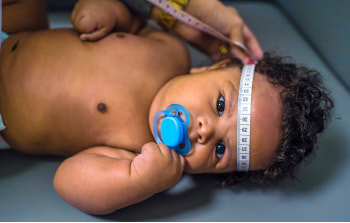What Causes a Cephalohematoma in a Newborn?
Cephalohematoma is a condition that causes blood to build up under a newborn’s periosteum (the tissue that covers the skull) following birth. The pooled blood looks like a bump on the top of the head and is usually harmless.
Newborn cephalohematoma causes blood under an infant’s scalp to pool due to broken blood vessels.
Newborn cephalohematoma causes include a baby’s head pushing against the mother’s pelvis, force from assisted-delivery devices, and the infant’s size and position in the womb. In some cases, newborn cephalohematoma causes are unavoidable, but medical malpractice may be involved in other situations.
Here are some common newborn cephalohematoma causes.
Assisted-Delivery Device Complications

Complications from assisted-delivery devices, such as forceps and vacuum extractors, can cause a newborn cephalohematoma due to too much pressure or suction. Improper use of these devices is sometimes what causes a cephalohematoma in a newborn.
Baby’s Head Pushing Against Mother’s Pelvis
Cephalohematoma can happen when an infant’s head pushes against the mother’s pelvic bone during childbirth. In these cases, the bump develops due to ruptured blood vessels on the baby’s scalp.
Baby’s Position
Babies not in a head-down, back-facing position may experience longer delivery times and require a doctor to use assisted-delivery devices.
Baby’s Size
Infants who are larger than average (fetal macrosomia) and weigh more than 8 pounds 13 ounces are more likely to push against the mother’s pelvis, resulting in cephalohematoma in newborn babies.
Medical Negligence
Avoidable mistakes due to medical negligence during delivery can lead to newborn cephalohematoma and other birth injuries.
When newborn cephalohematoma causes involve medical negligence, you may be able to access financial compensation. Get a free and confidential consultation now.
Risk Factors for Cephalohematoma
While newborn cephalohematoma causes and risk factors are similar, it is important to understand that they are not the same.
Risk factors are associated with the condition but do not necessarily cause it.
Here are some of the main risk factors for cephalohematoma.
Carrying Multiple Babies
Expectant mothers carrying multiples (twins, triplets, or more) have a greater chance of delivering babies with cephalohematomas. This is because delivering multiple babies increases the risk of complications overall.
Extended Time in the Birth Canal
Lengthy or prolonged labor increases the need for assisted-delivery devices, which makes injuries more likely.
Labor Difficulties
Doctors are more likely to use assisted-delivery devices to help deliver a baby during difficult labor. As a result, these babies are more likely to develop cephalohematoma.
Premature Birth
Premature babies are more likely to develop a cephalohematoma due to their fragility and other difficulties associated with an early birth.
Use of an Epidural
Using epidural pain relief during delivery is linked with an increased risk of delivering a newborn with a cephalohematoma. This is because epidurals can cause numbing that decreases a mother’s ability to push a baby out. When this happens, a doctor may decide to use assisted-delivery devices to deliver the baby.
If you have questions about newborn cephalohematoma causes, connect with one of our labor and delivery nurses.
What to Do for Infant Cephalohematoma
First, tell your child’s health care provider if you suspect your child has cephalohematoma.
Infants with cephalohematoma often experience these symptoms:
- Collection of blood that looks like a soft bump
- Feeding difficulties
- Larger than average head size
- Pain in the skull area
- Seizures
- Vomiting
A medical professional will be able to determine whether your child has a cephalohematoma or just bruising.
What to Expect With Newborn Cephalohematoma
Finding out your baby has a birth injury can be scary, but most cephalohematomas are mild, go away on their own, and are treatable when caught in time.


Once the medical team has diagnosed the cephalohematoma and its potential for complications, they may suggest several treatments.
Newborn cephalohematoma treatment may involve:
- Antibiotics for infection
- Blood transfusion for anemia
- Light therapy for jaundice
- Monitoring for skull fractures
- Surgery to drain blood, tie off small blood vessels, remove large clots, or remove calcification deposits
The prognosis for newborn cephalohematoma is generally favorable. If diagnosed and treated properly, most babies will recover in several months.
Complications of Cephalohematoma
If the doctor diagnoses your baby with cephalohematoma, they can determine whether treatment is required. They can also monitor for cephalohematoma complications.
Complications of cephalohematoma are rare and often occur when the condition is left untreated or undiagnosed for an extended period.
- Anemia: A Cephalohematoma can cause anemia (low blood count) by removing blood from the infant’s circulatory system.
- Calcifications: These hardened bone deposits around the cephalohematoma mass must be corrected (sometimes surgically) after diagnosis since they can affect the child’s skull formation.
- Infections: Newborns with cephalohematomas are more prone to infections. In rare cases, an infection can lead to life-threatening cellulitis (infection of the skin and tissue under the skin), osteomyelitis (bone infection), or sepsis.
- Jaundice: This condition can occur when the baby’s body absorbs the blood from the cephalohematoma. Jaundice in newborns causes a yellowish appearance of the whites of the eyes and skin.
- Skull fractures: Up to 25% of babies with cephalohematomas also have a linear skull fracture. A linear skull fracture is a break in the skull that looks like a thin line.
Get Help With Newborn Cephalohematoma Caused by Medical Negligence
Newborn cephalohematomas usually go away on their own without any complications or side effects. However, in rare cases, this birth injury can cause life-threatening infections.


When medical negligence causes a newborn cephalohematoma, families should not have to bear the emotional and financial burden alone.
By connecting with a birth injury law firm, you can find out if you have a birth injury lawsuit. You may be able to recover financial compensation for your child’s medical costs and pain and suffering.
Get a free case review today to see if you qualify.
Newborn Cephalohematoma Causes FAQs
Are newborn cephalohematoma and caput succedaneum the same thing?
No, newborn cephalohematoma and caput succedaneum are not the same. While both are birth injuries involving swelling or bumps on the baby’s head, they are two different conditions.
Cephalohematoma involves bumps caused by a pool of blood under the scalp, while caput succedaneum involves bumps caused by scalp swelling due to pressure. Both conditions are usually harmless and resolve on their own.
Can newborn cephalohematoma be caused by trauma to the head?
Yes, newborn cephalohematoma is caused by trauma affecting a child’s head.
Head trauma in newborns can happen when:
- Assisted-delivery devices such as vacuum extractors or forceps are used
- The baby is larger than average
- The child’s head pushes against the mother’s pelvis during childbirth
- The newborn is breech (feet or buttocks first)
- Healthcare providers make preventable medical mistakes
What is the most common complication of newborn cephalohematoma?
Newborn cephalohematomas are usually harmless. However, they can cause complications like jaundice, anemia, and life-threatening infections. In rare instances, the newborn may also have skull fractures that usually heal on their own.
Can newborn cephalohematoma be prevented?
Some cases of newborn cephalohematoma could have been prevented with proper medical care. Expectant mothers can help prevent it by learning what causes a cephalohematoma in a newborn and understanding their specific risk factors.
How do I get help if my baby’s birth injury was caused by hospital negligence?
If you believe your child’s cephalohematoma was caused by your medical team’s negligence, get a free case review to learn about your legal options.




